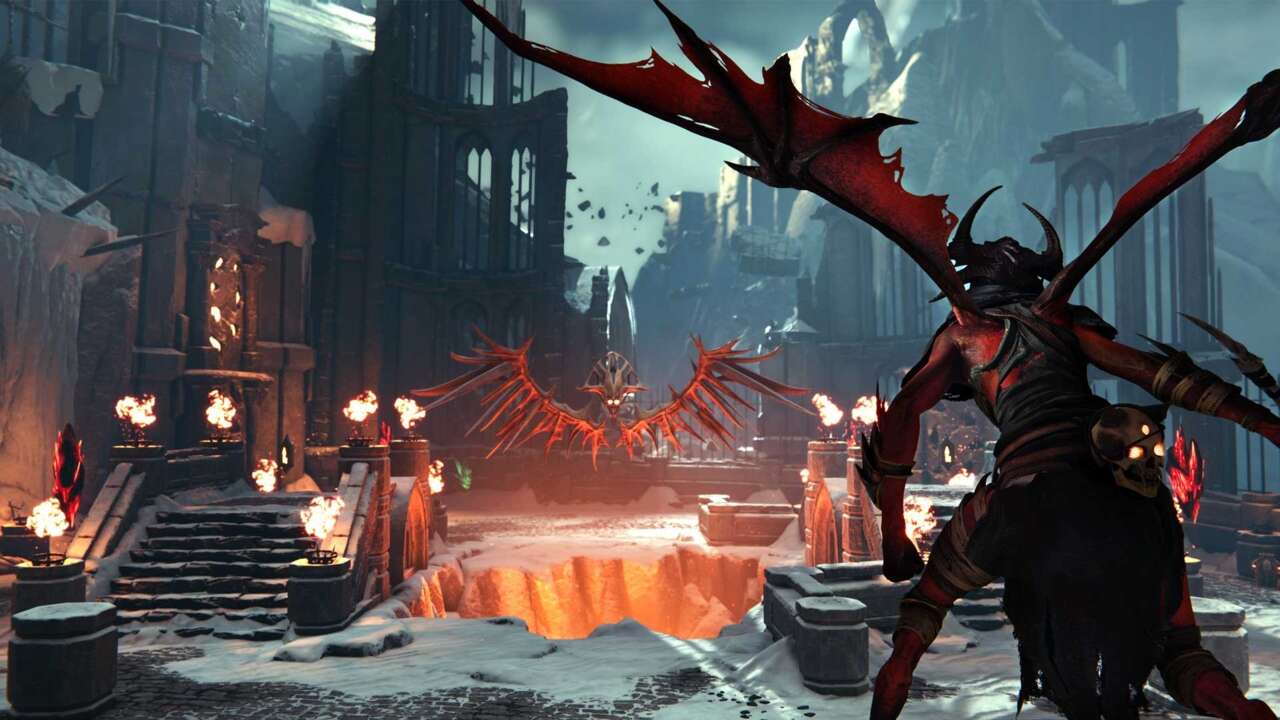First-person shooter combat can often be said to have a sort of “rhythm,” with the explosive bassy blasts of rounds leaving firearms and the weighty ka-chunk of reloading adding its own percussion to action movie-like experiences. Metal: Hellsinger makes that idea its central tenet, specifically building a fast-paced arena shooter around rhythm game sensibilities. But while it might seem like shooters naturally lend themselves to a rhythm game concept, making Metal: Hellsinger work as one, while ensuring it’s still a satisfying shooter, meant that developer The Outsiders had to allow the music to permeate every facet of the game’s design.
Just ahead of Summer Game Fest, The Outsiders released a free demo for Metal: Hellsinger on Steam that offers a look at one level of the game, as well as a boss fight. Playing as a demon called The Unknown, you shoot your way through the hordes of hell with a variety of weapons; the demo includes a shotgun and a pair of revolvers, as well as a sword and a flaming skull that spits fireballs. The better you keep the beat with your attacks, the higher your score multiplier rises; with it, the music playing in the game’s level becomes fuller and more intense, and even the environment reacts to your slayage. Maintaining the beat keeps your multiplier up, while certain actions, such as reloading, reward you for your syncopation by getting you back to the battle faster. And at least one action, a brutal execution move that rewards you with a spray of health items, can only be performed if you activate it on-beat.
At Summer Game Fest, combat designer Adam Wrange explained what The Outsiders has had to do to keep time throughout Metal: Hellsinger, joking that he’s had to add studying music theory to the duties of his job. Keeping the player with the beat is one thing, but in order to make the game feel satisfying, everything else has to be keyed to the music as well. It wouldn’t do for the player to be forced to hold back a shot in order to keep rhythm while enemies attack whenever they feel like.
“We tried to do that in all aspects of [Metal: Hellsinger], because if you’re attacking with the beat, then the enemy should move with the beat,” Wrange said.

Syncing everything to the beat in Metal: Hellsinger keeps the game feeling like a fast, satisfying arena shooter, even as you adjust your actions to the rhythm.
But that presented its own problems, since not every level features the same music, and thus some levels have faster or slower beats than others. Developers created internal systems that defined the beat for everything in the game, allowing them to scale enemy and player actions so they could fit the rhythm no matter what song was playing.
“We have a system running in the background that always tells us, ‘This is the beat. This is the beat. This is the beat,'” Wrange said. “So all of the systems for you, the player, [as well as] the enemies, and some of the environmental stuff that we have, they’re all hooking into that same thing. We can tell the entire game when the beat is happening.”
The beat systems keep enemies on-track by limiting their ability to execute attacks. As Wrange described it, every time there’s a beat, the system creates what you might consider an “attack ticket.” Enemies can’t attack unless they’ve received a ticket from the system, and the system refills on beat, which means that enemies can only attack on beat as well. Not everything can always sync up perfectly–for instance, a gun-toting enemy will fire their projectile on-beat, but the game doesn’t calculate a bullet’s air time and adjust its speed to match the beat. As can be seen in the demo, though, the system creates a lot of situations in which it feels like enemies are dancing toward you and then leaping at your face as if they’re spurred on by the metal bands Metal: Hellsinger features throughout its soundtrack.
While the rest of the game keeps the beat in order to make Metal: Hellsinger feel rhythmic as well as fair, for players, the situation is more like a jam session or a collaboration. Your weapons are your instruments as you play the game, and they’re designed with both their lethal and musical capabilities in mind, Wrange said. While other games can include weapons with delayed reactions or that shoot items like explosives, the guns in Metal: Hellsinger have to be viable in keeping the beat as well as in battle.

Firing a weapon includes multiple actions for each gun to help you keep the beat and provide you a way to play along to the music.
Like enemies and their animations, weapons are also designed with the beat in mind. You might fire your dual revolvers, the Hounds, with the beat, but the animation of pulling back the hammer after a shot also matches the rhythm. In that way, Wrange said, the weapons can provide you with a little help to keep you synced up, while also adding to the musical nature of your destruction.
“Something that helped with a weapon is that even if it’s only firing on one beat, it needs to have a secondary reaction happening after you fire it so that it feels like the weapons have their own rhythm,” he said. “And that was super important. That helped sell the entire weapon for us.”
Wrange said that thinking about the flow of music even came down to the level designs.
“We’re kind of like, ‘Okay, so we know we’re going to have this kind of length [for the level].’ And we were trying to almost look at how a classic song is shaped and imitate that, and take the look of that into the song,” he said. “Like, ‘Okay, we’re doing this thing here and then we’re going up for the chorus and then we’re going for the next thing.’ Trying to pace that through the verses and the chorus, somewhat. I wouldn’t say that you get that immediately, but we thought a lot about that when we were doing it. And there’s a formula to how we built the levels as well.”
Metal: Hellsinger features vocals from a number of well-known metal musicians, including System of a Down’s Serj Tankian, with its soundtrack composed by Swedish duo Two Feathers, who Wrange said worked with designers and concept artists to get inspirations for songs as the game was being made. So levels weren’t built around specific pieces of the soundtrack, but instead they were being created more or less simultaneously, with the different teams working closely together.

Levels and encounters in Metal: Hellsinger are designed to flow like a song.
“We started building, blocking out the levels and putting out a pace for it. And then we got the concept art coming in. And then I had a conversation with the music people about that, and they were looking at the concept art and looking at running through the level to feel like that. And that helped them inform how they were also writing the music. So it was really a collaborative effort between both how we were writing the music and how we were shaping the levels.”
That collaboration, and the different musical inspirations, comes through even in the short portion of Metal: Hellsinger available in the demo. Despite the fact that rhythm gameplay and shooter mechanics feel like a natural pairing, there’s a lot going on in Metal: Hellsinger to make the two work together. It’s a testament to its music and design that, at least in the demo, it’s easy to forget about how the game works as the vocals rise, the enemies fall, and the bullets fly to the beat.
Metal: Hellsinger is set to release for PC, PlayStation 5, and Xbox Series X|S on September 15.
Source: Gamespot





















